“I think I’m lost.”
Twenty miles had passed since departing the only hotel in Cumberland, Kentucky, that had a sign hanging in a broken window that read, “Closed.” That’s when the thought came to mind that I might be in trouble. I’d been traveling lonely State Route 522 for a while now, searching for a new stopping point. Shadows lengthened across the pavement as the day drew to a close, so I dialed up a little more throttle. I’d intended to lose myself a little on this ride, but not this much.
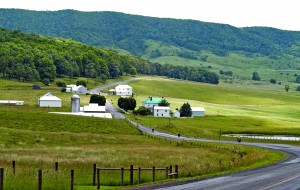
My plan for a three-day journey through the Appalachians had already slipped from Plan B to C. Now I was on D. Slabbing it down to Kentucky, the GPS conked out. Paper maps? Forgotten on the desk at home. The backup map I’d bought at a gas stop wouldn’t do me much good here in Kentucky. It was a Virginia map.
Not knowing how far to ride or what size town I would encounter next, that’s just how I felt. Lost.
It’s a recurring theme throughout Appalachian history, music and folklore. Songs mourn the loss of loved ones. Stories tell about lost ways of life, livelihoods and values. Whenever the description of a place in Appalachia begins with “Once thriving…” you know the rest of the story. It’s been lost.
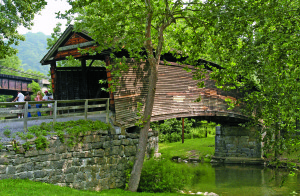
I snagged the last room in Harlan, Kentucky, and reset plans to launch my unscripted trek from there. Recalling previous runs, I vaguely remembered one back road out of Harlan that would bring me to a small coal town on the border between Kentucky and Virginia. I’d never taken it. I’d settle that tomorrow.
I wouldn’t be surprised if Route 38 out of Harlan was once used for smuggling hooch into Virginia. Probably still is. After bolting straight out of town for a few miles, it bobs and weaves through heavy forest like a moonshiner dodging shots from a revenuer in hot pursuit. Under dazzling blue skies, my Honda ST1300 found its way effortlessly through the esses, popping over a ridge in the Black Mountains where a roadside vantage point reveals endless waves of blue-green hills—the perfect spot to consider what challenge to mount next.
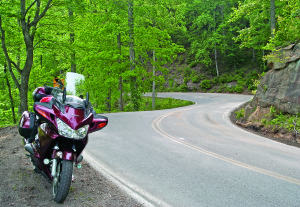
Rides like this are well suited to the ST. It’s not a light bike by any means, but disguises that heft well, especially at speed. Shod with stock Bridgestones, the bike feels confident over Appalachian secondary roads that tilt and twist in unpredictable ways. A weekend’s worth of gear stuffs easily into the saddlebags, leaving the top case for gear I like to have at hand, like a camera or a quick snack. The few improvements I’ve made over the years have focused on improving long-distance comfort, such as highway pegs and a backrest. But for the task at hand, the emphasis was clearly on the sport side of the sport-touring equation.
Winding down the backside of the mountain, the route intersected Virginia State Route 160 just outside Appalachia. Route 160 between Appalachia, Virginia, and Cumberland, Kentucky, is one wild ride. It features 25 miles of stacked switchbacks with no guardrail, so the 55 mph speed limit is both generous and self-enforcing.
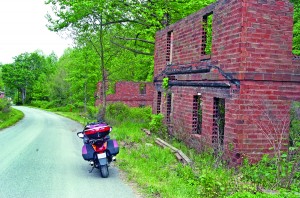
Arriving in Appalachia, I cruised through a mostly deserted downtown on my way to Derby. Company towns like Derby were built in isolated areas where transportation was limited and resources were rich and worthy of exploitation. Derby was the last of its kind, built for workers by the Stonega Coal Company in the 1920s. From photographs I’d seen in its early days, Derby provided well for its original inhabitants with all the trappings of a vibrant small town. Pictures depict a beehive of commerce tucked away on a strip of flat bottomland in a narrow hollow filled with turn-of-the-century architecture and busy streets. Churches and theaters. Barbers and banks. I was curious to see what remained.
Traveling up Route 78 from Appalachia, I hung a left on Derby Road and followed it to the end. Rows of identical homes lined the road to Derby, some neatly kept, a few collapsed and returning to the earth. Near the end of the road, the few remnants of Derby resided in crumbling foundations and rusting bits of machinery. The last section of the road was closed to traffic. A controversial and destructive form of mining called the mountaintop removal method is slowly but surely burying what remains of the town, never to be seen again.
Derby, Virginia. Once thriving.
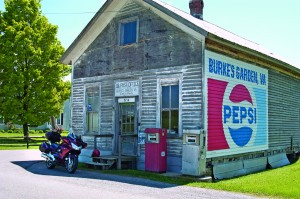
Humbling scenes like this depict all too vividly the temporary nature of the human condition, but the natural beauty of the region perseveres. Returning to Appalachia, a brisk ride on a flat and twisty ribbon of old U.S. 23 restored the mind and spirit. Now in Virginia, maybe that map would do me some good. In Norton, I pored over the folds, looking for the best way to reach Fort Blackmore, another lost town. There was the long way ’round, or the short way. The short way was a jagged line of road, a run of about 12 miles labeled Route 619 that cut across the Bear Country Wilderness. The map foretold of an improved road and a future of riding pleasure.
The first few miles to Flag Rock were a blast. From third to second to first, I kept dropping gears to match the steep rise and tight cutbacks up the mountain. The back side was a different story. The blacktop ended just over the peak, turning into a long, slow descent of hard-packed gravel. A few miles of gravel is no big deal, so I pressed on. Facing declines just as steep, the bike and I literally crawled down the mountain with gravel giving way to hard, wet and slick dirt. Had I crossed paths with an angry mama bear, I’d have been screwed. I had an hour to think about that as I crept toward the next sign of civilization. When pavement finally reappeared, I stopped for a breather and lunch at a local store. I removed the map from my top case, wadded it up and tossed it in the trash. I could do better without it.
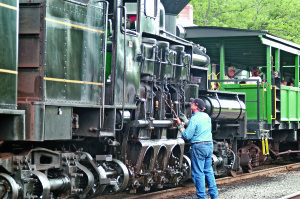
My target destination was Bluefield, West Virginia. Having spent far more time than I’d planned slogging through the wilderness, I simplified my route by following Routes 65 and 71 to Lebanon. Turning north on U.S. 19, I opened up the bike, kicked out the highway pegs and settled against the backrest for a few dozen miles of power touring. Bluefield rolled into sight in the late afternoon.
While Bluefield has avoided the “once thriving” label, it may never regain its original stature. A century ago, Bluefield had true urban credentials—high-rise buildings, the first “rush hour” traffic and more millionaires than anywhere else in the country. But you can guess the rest of the story. The town’s fortunes turned entirely on the success of coal. As the coal played out, so did the town. Today, Bluefield, like many Appalachian towns, is pinning its hopes on a new economic base: Tourism.
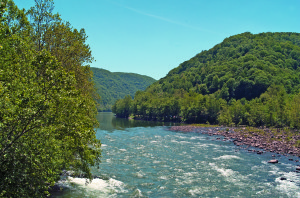
Another day, another brilliant blue sky. I decided today to aim for some of the better roads through West Virginia and head toward the New River Valley. If you haven’t ridden the Mountain State, put it on your bucket list. Forget about the hillbilly stereotypes, West Virginia is filled with friendly people and hundreds of miles of wide-open, well-paved roads. Heading out of Bluefield, I took the circuitous route, first heading east along U.S. 460 to Rich Creek, Virginia. North on U.S. 219 brought me to Lewisburg, West Virginia, where I picked up U.S. 60 and turned west. If you pull out a map (a good one, please), mark West Virginia routes 20, 41 and 39. These will provide another day’s worth of riding entertainment and enough curves to satisfy any canyon carver.
A turn south on U.S. 19 brought me to the New River Gorge Bridge, one of the highest and longest found anywhere. Fayetteville, located along the south rim of the gorge, is a funky little outpost filled with river runners and small cafés run by an eclectic mix of old timers and beatnik imports. I stopped by the Cathedral Café for a quick lunch and a slice of their famous carrot cake. Located in a converted church, the café features soaring ceilings and stained glass windows, book-lined walls and hand-painted tables. Oh, and WiFi. Glancing around at the mostly youthful and studious-looking clientele, I expected a poetry slam to break out at any moment.
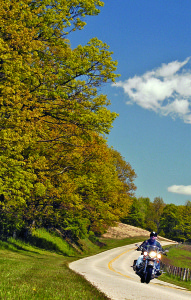
I decided it was time to move on before the couplets and pentameters started flying, so I picked up U.S. 19 south to Glen Jean. A brown road sign marks the turn for the New River Historic District. A turn north on State Route 16/61 then leads to County Road 25, the road to Thurmond. It’s a ride of 10 miles on a narrow strip of pavement, passing through haphazard settlements, over creeks and across active railroad lines.
Thurmond, one of dozens of settlements that popped up along the gorge in the late 1800s, is today the dictionary definition of “once thriving.” A virtual ghost town. Both coal and timber drew businesses and residents to the area and, as a strategic commerce center, Thurmond prospered more than most. Within a few years of settlement, Thurmond boasted multiple hotels, banks and dozens of businesses. Thurmond permitted no illicit activities within its borders, but across the way, a different set of rules applied. Any activity you might care to pursue could be found on the other side of the river, including a poker game that ran continuously for 14 years at the Dun Glen Hotel.
By the mid ’30s, the town began a rapid and irreversible decline as the Great Depression amplified the effects of diminishing timber harvests and coal shipments. By 1984, what remained was purchased and preserved by the National Park Service. Looking through the empty store windows and standing at the front of the Thurmond National Bank, I couldn’t help but wonder about the fortunes and fates of the people who once lived here. In just 50 years, a town was born, prospered and died. Like Derby, it had barely begun life before it all ended.
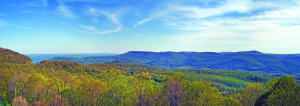
Headed toward Marlinton for the night, I retraced my steps to State Route 61 and followed it to routes 41 and 39. Or so I thought. My mind was still thinking about Thurmond, wondering what my own hometown might look like in 50 or 100 years. In a while, I realized nothing looked familiar and I had little idea where I was. I was lost. But that’s OK, I decided. That’s just where I wanted to find myself.
(This article Lost and Found: Seeking Direction in the Appalachians was published in the March 2013 issue of Rider magazine.)
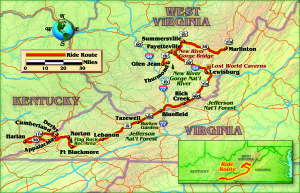 |
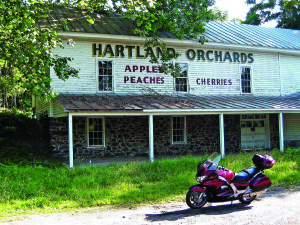 |







